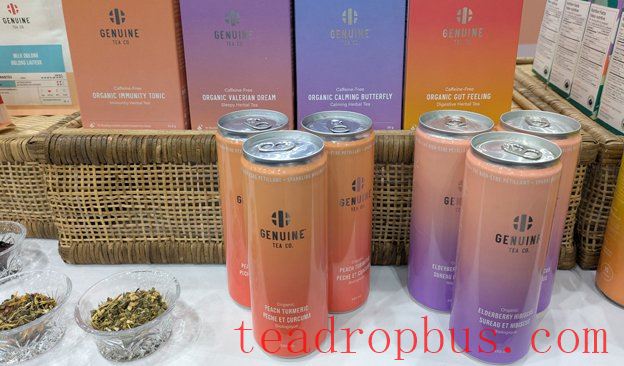
Growth-minded tea brands, emerging or established, can pursue several strategies to thrive in the evolving landscape. Photo credit Diana Jendoubi
In a landscape dominated by cafe culture and crowded grocery shelves, a familiar question reverberates throughout the tea industry: Has the tea market reached a saturation point? For entrepreneurs and established businesses, understanding the true state of the tea market and its future potential is key to making smart, strategic decisions.
Is the Tea Market Saturated?
At first glance, the US tea market appears crowded. A proliferation of online tea retailers, overstuffed store shelves, and an ever-expanding array of offerings from legacy brands all suggest that the category is bursting at the seams. But a closer look at the numbers tells a different story.
According to the Tea Association of the USA, the US tea market reached nearly $14 billion in 2023, up about $1 billion since 2021. This steady growth points to expansion, not stagnation, especially when compared to the US coffee market, which generated approximately $99 billion in retail sales that same year (Mintel). It becomes clear just how much room tea still has to grow.
Much of the saturation narrative stems from the tea industry’s low barriers to entry, particularly in direct-to-consumer models that bypass traditional retail. This ease of access creates the illusion of crowding, but in reality, opens the door to innovation and specialization.
Tea’s accessibility creates what might be called an “entrepreneurial paradox.” The simplicity of launching a tea brand means many new entrants, which can make the market feel saturated. But this accessibility is also what drives the category’s evolution.
New brands can enter the market with minimal capital, especially through e-commerce. As a result, today’s tea industry is rich with diversity, with brands catering to niche tastes, wellness goals, brewing styles, and cultural preferences.
Rather than competing over a fixed share, businesses are helping to expand the entire market by acquiring new consumers. The challenge isn’t overcrowding; it’s about honing identity, standing out with authenticity, and connecting with the right audiences. The tea industry is not competing with itself but with other beverages instead. This is commonly referred to as “share of throat.”
Is the Tea Industry Stuck in Old Ways?
Despite its long history and incredible diversity, the tea industry is surprisingly conservative in its innovation. For all the buzz about specialty and wellness-focused products, many companies still rely on traditional formats and conventional branding. This leaves three key areas ripe for transformation: product innovation, brand storytelling, and technology adoption.
Tea has the potential to be as dynamic as any other beverage. Many companies miss opportunities to create novel experiences that appeal to modern consumers. Pique Tea is one company pushing the boundaries. Their crystallized tea concentrates dissolve instantly in water, appealing to health-conscious, convenience-driven consumers. By blending quality and convenience, they’ve attracted new audiences without sacrificing quality.
Tea’s five-thousand-year history is steeped in story, culture, ritual, terroir, and craftsmanship. Yet too many companies settle for generic packaging and formulaic marketing that fail to convey what makes their products meaningful. Nepal Tea Collective offers a compelling contrast. Their brand centers on producer equity, transparency, and heritage, building emotional, relevant connections with consumers who want more than just a good cup. They want a product they believe makes a difference.
Many tea brands lag behind in a digital-first world. From marketing to supply chain management, technology remains an underutilized tool. DAVIDsTEA is integrating its mobile app to create a seamless omnichannel experience and valuable consumer data that fuels product development and inventory management. When done right, tech doesn’t just streamline operations; it deepens customer engagement.
Growth-minded tea brands, emerging or established, can pursue several strategies to thrive in the evolving landscape:
- Niche Specialization: More brands find success by focusing deeply on well-defined audiences rather than casting a wide net. Jesse’s Tea House, for example, uses content to cultivate a devoted community, aligning every touchpoint with its core audience’s focus on Chinese tea culture.
- Vertical Integration and Transparency - Brands that can forge direct relationships with growers gain more than supply control. They build compelling stories and ensure quality from the source, and deeper consumer trust. The brand, Tea Rebellion, is one successful example of how supply transparency can be a major differentiator. They celebrate their tea’s origins and producers, instead of shielding them from public view.
- Experience-Centric Models - Modern tea drinkers aren’t just looking for a beverage; they’re seeking rituals, mindfulness, and connection. Brands that design immersive experiences around tea can foster loyalty and offer valuable intangible benefits to customers. Cha&, a modern tea bar in Manhattan, offers tea drinks that defy customer expectations, like shaken, cold-brewed Japanese green teas served in champagne flutes.
- Sustainability as Strategy - Sustainability is no longer optional. Companies like Satemwa in Malawi demonstrate how eco-conscious production and social responsibility can differentiate products while addressing the ethical concerns of increasingly informed consumers.
The tea market isn’t saturated; it’s maturing. Accessibility may invite competition, but it also creates fertile ground for innovation and ensures differentiation between tea brands. The vast gulf between the tea and coffee markets signals significant untapped potential. By focusing on innovation, storytelling, and serving a niche, businesses can grow and help redefine what tea means to the next generation of drinkers worldwide.